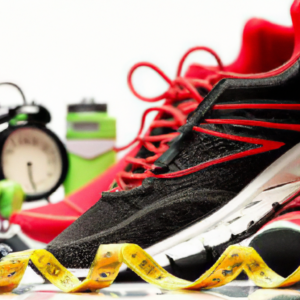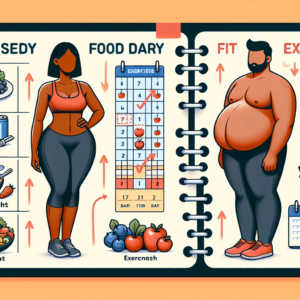Are you looking to shed that stubborn belly fat quickly? If so, then look no further! In this article, you will discover effective tips and strategies to help you say goodbye to unwanted belly fat. With these simple yet powerful techniques, you can embark on your journey towards achieving a flatter and more toned midsection. Get ready to surprise yourself with the incredible progress that awaits you. Say hello to a fitter and healthier you!

Exercise
Cardiovascular exercises
Cardiovascular exercises, also known as cardio exercises, are one of the most effective ways to burn belly fat quickly. These exercises get your heart pumping and increase your overall calorie burn. Some popular cardiovascular exercises include running, cycling, swimming, and jumping rope. Aim for at least 150 minutes of moderate-intensity cardio exercises or 75 minutes of vigorous-intensity cardio exercises every week.
Strength training
Strength training is another crucial component of losing belly fat. It not only helps build lean muscle mass but also boosts your metabolism, leading to increased calorie burn even at rest. Incorporate exercises such as squats, deadlifts, lunges, and push-ups into your workout routine. Aim to do strength training exercises at least two to three times a week, targeting all major muscle groups.
High-intensity interval training (HIIT)
High-intensity interval training (HIIT) is a fantastic way to torch belly fat. HIIT involves short bursts of intense exercise followed by periods of rest or low-intensity exercise. This type of training keeps your heart rate elevated and increases your fat-burning potential. Workouts such as sprint intervals, high knees, burpees, and mountain climbers are excellent choices. Aim for two to three HIIT sessions per week, alternating with cardio and strength training workouts.
Abdominal exercises
While spot reduction is not possible, targeted abdominal exercises can help tone and strengthen your midsection muscles. Exercises such as crunches, planks, Russian twists, and bicycle crunches can help enhance muscle definition and provide stability to your core. Incorporate these exercises into your workout routine two to three times a week, alongside other exercises for overall fat loss.
Pilates and yoga
Pilates and yoga are low-impact exercises that focus on core strength, flexibility, and posture. These exercises not only help strengthen your abdominal muscles but also enhance overall body awareness and promote relaxation. Pilates exercises like the hundred, single-leg stretch, and roll-up can engage your core effectively. Yoga poses such as the boat pose, plank pose, and bridge pose can also target your abdominal muscles. Include Pilates or yoga sessions at least once or twice a week to complement your other workouts and promote well-rounded fitness.
Diet
Eat a balanced diet
Maintaining a balanced diet is essential for overall health and effective weight loss. Include a variety of fruits, vegetables, whole grains, lean proteins, and healthy fats in your meals. Aim for a colorful plate, ensuring you get essential nutrients from different food groups. Be mindful of portion sizes and try to eat smaller, frequent meals throughout the day to keep your metabolism steady.
Reduce calorie intake
To lose belly fat quickly, it’s important to create a calorie deficit. This means consuming fewer calories than your body needs. Start by identifying your daily calorie needs and then aim to reduce your calorie intake gradually. Be mindful of portion sizes, choose nutrient-dense foods, and consider tracking your calorie intake using a food diary or mobile app.
Increase protein consumption
Protein is a macronutrient that plays a crucial role in weight loss and muscle building. It helps keep you full, boosts your metabolism, and preserves lean muscle mass. Include lean sources of protein such as chicken, turkey, fish, tofu, Greek yogurt, and legumes in your meals. Aim for a protein-rich food at every meal to support belly fat loss.
Cut back on refined carbohydrates
Refined carbohydrates, such as white bread, white rice, sugary cereals, and pastries, can promote belly fat storage. These foods cause rapid spikes in blood sugar levels, leading to increased insulin production and fat accumulation. Opt for whole grain alternatives like brown rice, whole wheat bread, and oats, which provide more fiber and nutrients.
Avoid sugary beverages
Sugary beverages like soda, fruit juices, and energy drinks are packed with empty calories and can contribute to belly fat. These drinks provide little to no nutritional value and are often high in added sugars. Opt for water, unsweetened tea, or low-calorie alternatives like sparkling water or infused water to quench your thirst.
Include healthy fats
Contrary to popular belief, not all fats are bad for you. Healthy fats, such as those found in avocados, nuts, seeds, fatty fish, and olive oil, can actually aid in belly fat loss. These fats are rich in omega-3 fatty acids, which have been shown to reduce inflammation, promote satiety, and support overall heart health. Add moderate amounts of healthy fats to your meals for a well-rounded and satisfying diet.
Eat more fiber
A high-fiber diet can help you feel full for longer, reduce cravings, and promote healthy digestion. Include plenty of fruits, vegetables, whole grains, and legumes in your diet to increase your fiber intake. Not only will fiber aid in weight loss, but it will also support overall gut health and prevent constipation.
Stay hydrated
Proper hydration is crucial for overall health and weight loss. Drinking enough water can help boost your metabolism, curb appetite, and prevent overeating. Aim to drink at least eight cups (64 ounces) of water per day. Carry a water bottle with you throughout the day to stay hydrated and make it a habit to drink water before meals to help control your portion sizes.
Lifestyle Changes
Manage stress levels
Chronic stress can contribute to weight gain, especially around the belly area. Find healthy ways to manage stress, such as practicing relaxation techniques, deep breathing exercises, or engaging in activities you enjoy. Consider incorporating mindfulness or meditation into your daily routine to promote a sense of calm and reduce stress.
Get enough sleep
Adequate sleep is essential for overall health and weight management. Lack of sleep can disrupt hormones related to appetite control, leading to increased cravings and hunger. Aim for seven to eight hours of quality sleep each night. Establish a consistent sleep schedule, create a relaxing bedtime routine, and ensure your sleeping environment is calm and comfortable.
Limit alcohol consumption
Alcoholic beverages are not only high in calories but also affect your body’s ability to burn fat efficiently. Alcohol is processed by the liver, diverting its attention from metabolizing fat. Limit your alcohol consumption or consider abstaining altogether to support your belly fat loss efforts.
Quit smoking
Smoking not only poses numerous health risks but can also contribute to belly fat accumulation. The chemicals in cigarettes can alter your metabolism, increase appetite, and cause hormonal imbalances. Quitting smoking is essential for both your overall health and your weight loss journey.
Avoid late-night snacking
Late-night snacking can sabotage your efforts to lose belly fat. Your body’s metabolism slows down during sleep, making it harder to burn calories efficiently. Avoid eating within a few hours of bedtime to allow your body time to digest properly. If you do get hungry, opt for a light, protein-rich snack to satisfy your hunger without overloading on calories.
Practice portion control
Portion control is key when it comes to losing belly fat and maintaining a healthy weight. Be mindful of your portion sizes and utilize smaller plates and bowls to help visually control your serving sizes. Take the time to chew your food thoroughly and savor each bite, allowing your brain to register feelings of fullness.
Meal planning
Planning your meals in advance can help you make healthier choices and avoid impulsive food decisions. Take the time to plan your meals and snacks for the week, creating a grocery list and prepping ingredients in advance. This way, you’ll have nutritious options readily available and reduce the temptation to reach for unhealthy foods.
Hydration
Importance of water
Drinking enough water is crucial for overall health and weight management. Water is involved in numerous bodily processes, including metabolism and digestion. It helps flush out toxins, keeps your skin healthy, and supports proper organ function. Make sure to prioritize water intake throughout the day.
Drink water before meals
Drinking a glass of water before meals can help reduce calorie intake. It can create a feeling of fullness, leading to decreased overeating. Aim to drink a glass of water 30 minutes before each meal to enhance portion control.
Replace sugary drinks with water
Sugary drinks like soda and fruit juices are loaded with calories and contribute to weight gain. Replace these beverages with water whenever possible. If you find plain water boring, try infusing it with fruits or herbs for added flavor.
Infuse water with fruits and herbs
Adding fruits and herbs to your water can make hydration more enjoyable and flavorful. Try combinations like lemon and mint, cucumber and basil, or strawberry and kiwi. Experiment with different flavors to find combinations you love, and keep a pitcher of infused water in the fridge for easy access.

Metabolism Boosters
Increase protein intake
Protein has a high thermic effect, meaning your body burns more calories during its digestion and absorption. Increasing your protein intake can help boost your metabolism. Include lean sources of protein such as chicken, turkey, fish, tofu, eggs, and Greek yogurt in your meals and snacks.
Consume foods rich in iron
Iron is essential for proper metabolism and energy production. Include iron-rich foods like lean red meat, poultry, legumes, spinach, and fortified cereals in your diet. Iron helps carry oxygen to your cells, supports thyroid function, and aids in fat burning.
Drink green tea
Green tea is rich in antioxidants called catechins that have been shown to boost metabolism and aid in fat oxidation. Enjoy a few cups of green tea throughout the day to reap its metabolism-boosting benefits.
Eat spicy foods
Spicy foods containing compounds like capsaicin can temporarily increase your metabolism and promote fat burning. Include spices like cayenne pepper, chili powder, or jalapenos in your meals to add a kick to your metabolism.
Stay active throughout the day
Physical activity is not limited to structured workouts. Stay active throughout the day by incorporating movement whenever possible. Take regular breaks to walk or stretch, use stairs instead of elevators, and consider standing or walking while talking on the phone. These small habits can add up and boost your overall calorie burn.
Get enough vitamin D
Vitamin D deficiency has been linked to weight gain and metabolic disorders. Get adequate sun exposure or consider taking a vitamin D supplement with your doctor’s recommendation. Vitamin D supports healthy metabolism, immune function, and overall well-being.
Intermittent Fasting
What is intermittent fasting?
Intermittent fasting is an eating pattern that cycles between periods of fasting and periods of eating. It does not necessarily restrict specific food groups but focuses on when you eat. There are several different types of intermittent fasting.
Different types of intermittent fasting
Some popular types of intermittent fasting include the 16/8 method, where you fast for 16 hours and have an eight-hour eating window, and the 5:2 method, where you eat normally for five days and restrict your calorie intake to 500-600 calories for two non-consecutive days.
Benefits of intermittent fasting
Intermittent fasting has been shown to promote weight loss, improve insulin sensitivity, increase cellular repair processes, and reduce inflammation. It can also simplify meal planning and create a more mindful eating experience.
How to start intermittent fasting
If you’re considering intermittent fasting, start by choosing a fasting schedule that suits your lifestyle and goals. Gradually adjust to the fasting periods and seek guidance from a healthcare professional or registered dietitian if you have any underlying health conditions or concerns.
Stress Reduction
Effects of stress on belly fat
Chronic stress can lead to an increase in belly fat due to hormonal imbalances and elevated cortisol levels. Cortisol, the stress hormone, can promote fat storage in the abdominal region. Managing stress is essential for reducing belly fat and improving overall well-being.
Engage in relaxation techniques
Relaxation techniques such as deep breathing exercises, progressive muscle relaxation, and guided imagery can help reduce stress levels. Practice these techniques regularly to calm your mind and body, promoting a sense of relaxation.
Practice mindfulness and meditation
Mindfulness and meditation can help you become more aware of your thoughts, emotions, and bodily sensations. Regular practice can reduce stress, enhance overall well-being, and promote a healthy relationship with food. Consider incorporating mindfulness or meditation into your daily routine.
Spend time in nature
Spending time outdoors in nature can have a calming effect on the mind and body. Take walks in the park, go hiking, or simply enjoy the beauty of nature. Being in natural environments can reduce stress levels, improve mood, and promote relaxation.
Engage in hobbies and activities you enjoy
Finding joy and fulfillment in hobbies and activities you enjoy can help reduce stress and enhance your overall well-being. Whether it’s painting, playing music, gardening, or any other activity, make time for it regularly. Engaging in activities that bring you happiness can alleviate stress and support a healthy lifestyle.
Avoiding Belly-Bloating Foods
Foods to avoid
To reduce bloating and support belly fat loss, it’s important to avoid certain foods known to cause bloating. These may include carbonated drinks, high-sodium foods, processed foods, fried foods, and foods containing artificial sweeteners.
Reduce intake of processed foods
Processed foods are often high in sodium, unhealthy fats, and added sugars. These foods can cause water retention and bloating. Opt for whole foods instead, which are minimally processed and retain their natural nutritive value.
Limit sodium consumption
High sodium intake can lead to water retention and bloating. Be mindful of sodium levels in processed foods, canned goods, and condiments. Choose low-sodium alternatives or flavor foods with herbs, spices, or citrus juices instead.
Identify food sensitivities
Individuals may have specific food sensitivities or intolerances that can cause bloating and digestive discomfort. Common culprits include gluten, dairy, and certain FODMAPs (fermentable oligosaccharides, disaccharides, monosaccharides, and polyols). If you suspect any food sensitivities, consider consulting a healthcare professional or registered dietitian for guidance.
Avoid excessive alcohol and carbonated drinks
Alcoholic beverages and carbonated drinks can contribute to bloating and gas. Limit your consumption of these beverages or avoid them altogether to reduce belly bloating.
Proper Digestion
Chew food thoroughly
Chewing food thoroughly is an essential step in the digestion process. It helps break down the food into smaller pieces, making it easier for your body to digest and absorb nutrients. Take your time while eating, and aim to chew each bite thoroughly.
Eat smaller, frequent meals
Eating smaller, more frequent meals throughout the day can aid in digestion and prevent overeating. Large meals can put a strain on your digestive system and cause discomfort. Opt for smaller and balanced meals to support proper digestion.
Manage food intolerances
Food intolerances can lead to digestive symptoms such as bloating, gas, and discomfort. If you suspect any food intolerances, consider keeping a food diary to track your symptoms and identify potential triggers. Elimination diets or working with a registered dietitian can help manage food intolerances effectively.
Increase fiber intake
Fiber plays a vital role in digestion, promoting regular bowel movements and preventing constipation. Include fiber-rich foods such as fruits, vegetables, whole grains, and legumes in your diet. Gradually increase fiber intake to allow your body to adjust.
Consume probiotics
Probiotics are beneficial bacteria that can support a healthy gut and improve digestion. They can be found in foods like yogurt, kefir, sauerkraut, and kimchi. Alternatively, you can take a high-quality probiotic supplement to support a healthy gut microbiome.
Seeking Professional Help
Consult with a dietitian or nutritionist
If you’re struggling to lose belly fat or have specific dietary concerns, consulting with a registered dietitian or nutritionist can be beneficial. They can provide personalized guidance, create a tailored meal plan, and address any nutritional deficiencies or concerns you may have.
Visit a personal trainer
If you’re unsure about exercise techniques or methods to target belly fat, working with a certified personal trainer can provide valuable guidance. A personal trainer can create a workout plan suited to your goals, teach proper exercise form, and help you stay motivated.
Consider medical interventions
In some cases, medical interventions may be necessary to address underlying health conditions contributing to belly fat. If you’re experiencing significant difficulties in losing belly fat or have concerns about your overall health, consult with a healthcare professional who can provide appropriate guidance and potential medical treatments.
Get regular health check-ups
Regular health check-ups are important to monitor your overall health and address any underlying issues that may contribute to belly fat. Schedule routine appointments with your primary care physician or healthcare provider to ensure optimal health and well-being.
By incorporating these guidelines into your lifestyle, you can effectively target belly fat and improve your overall health. Remember to make gradual and sustainable changes, be consistent with your exercise and diet regimen, and seek professional guidance if needed. With dedication and patience, you can achieve a trimmer waistline and live a healthier, happier life.



